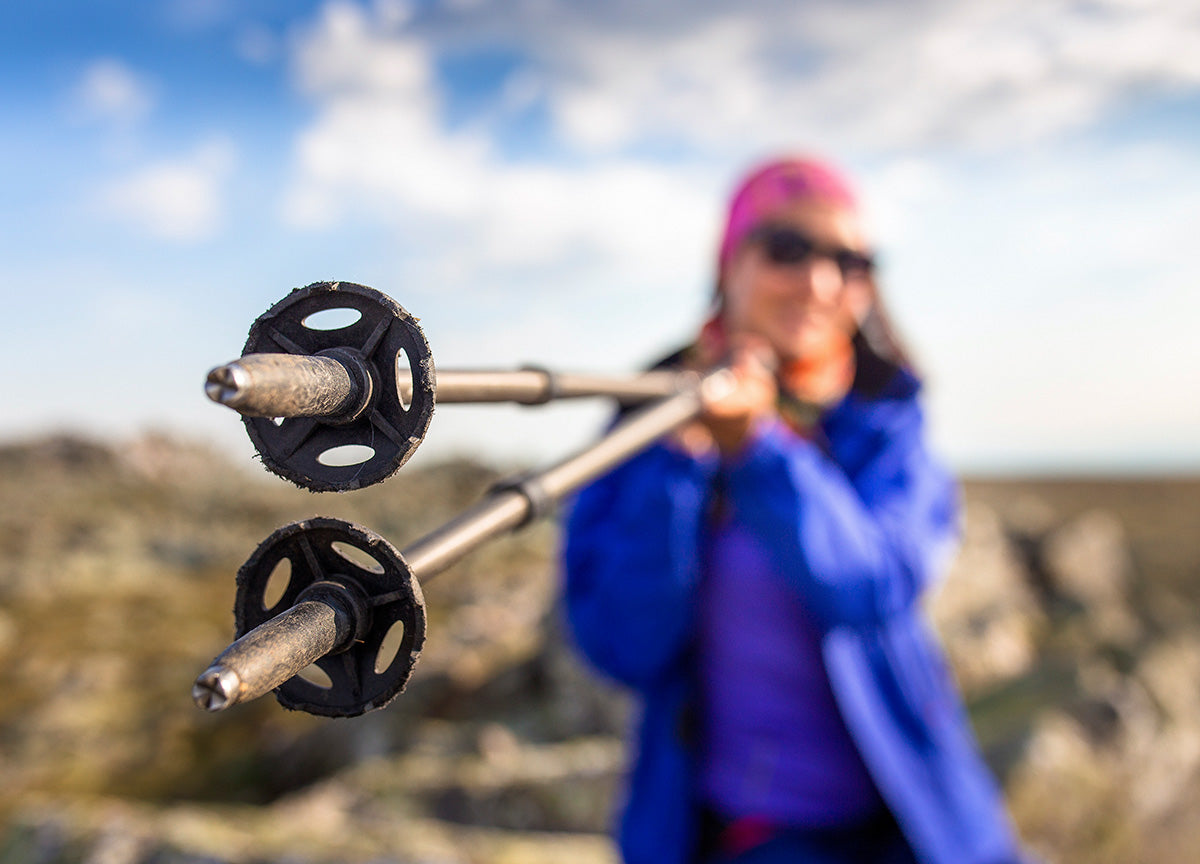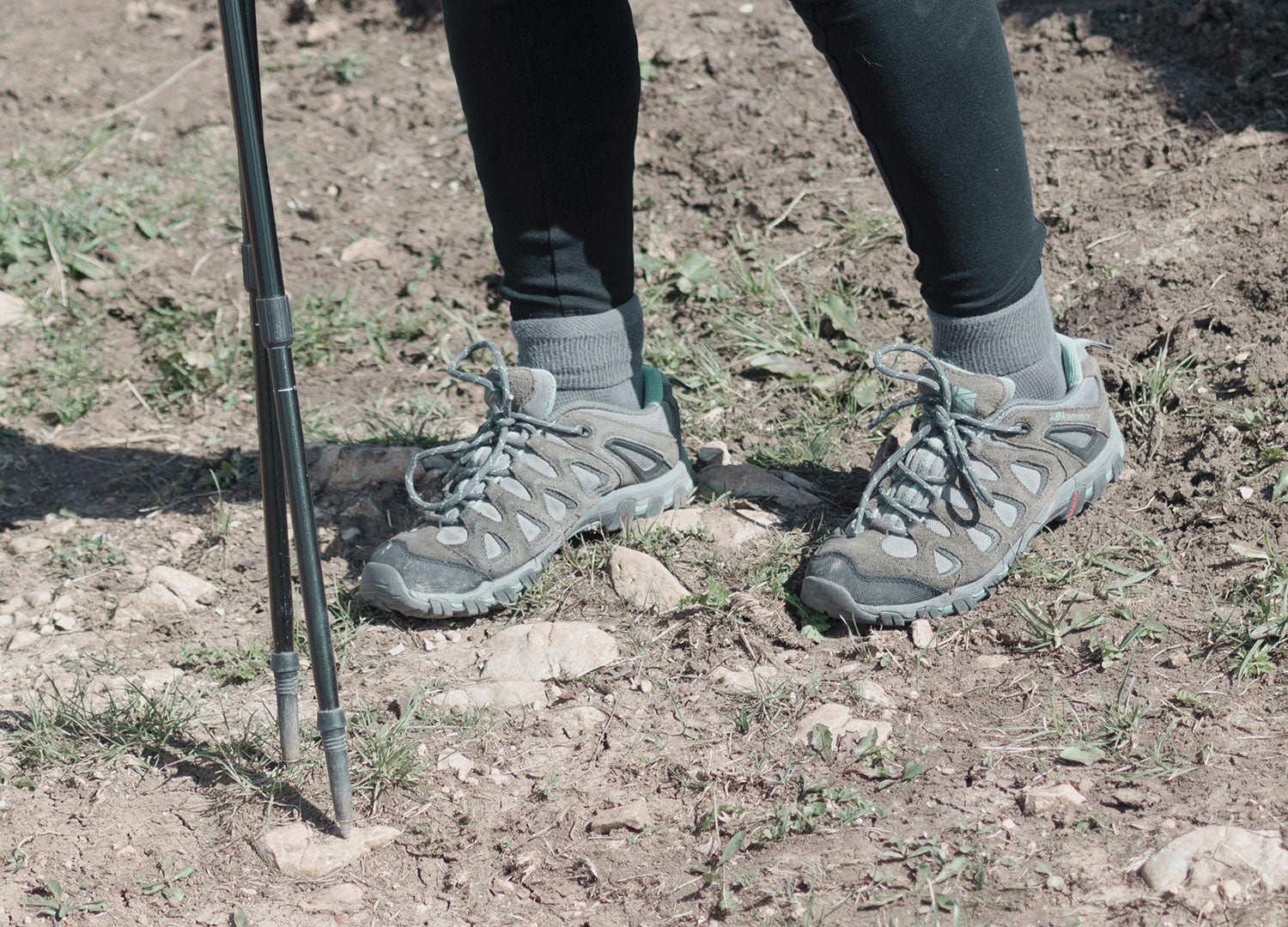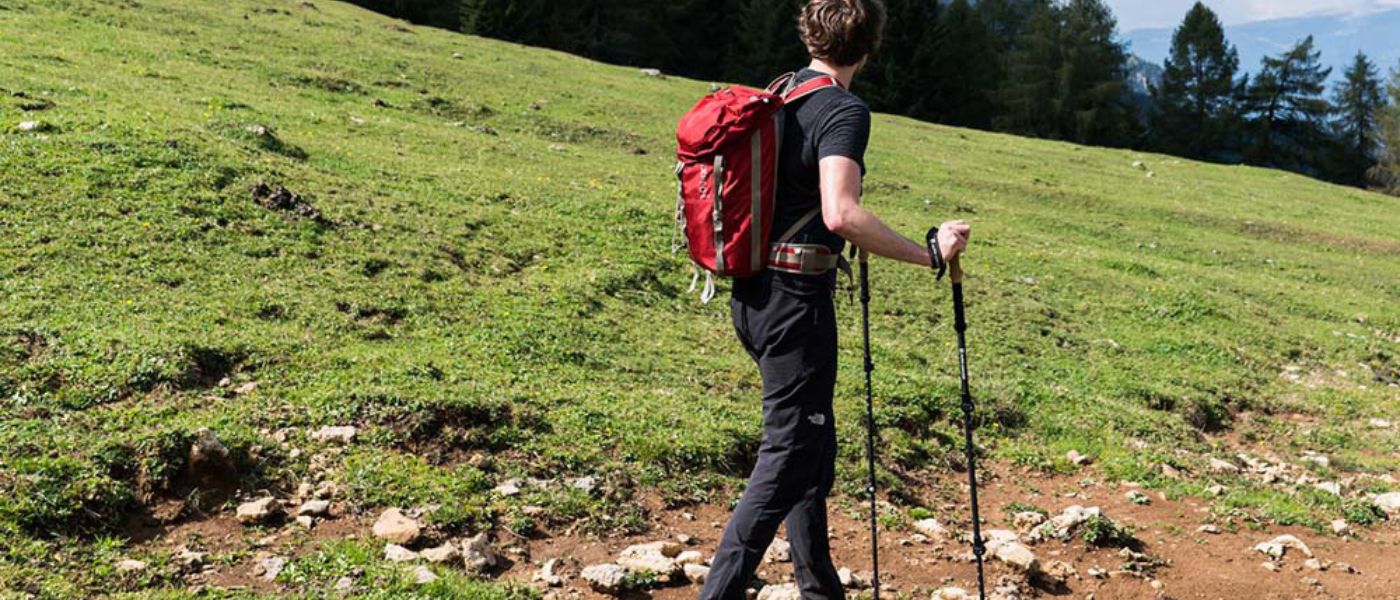Attachments for hiking poles
Trekking poles have four different buffers for tips. Which hiking pole tips are right for you depends on the terrain and the activity.
Asphalt tops
Asphalt tips are, as the name suggests, used on very hard surfaces. Concrete or asphalt surfaces damage the tip of the cane if used continuously. That is why there is a small black rubber shoe to protect the tip of your walking aid.

It makes no sense to combine rubber feet for asphalt with mud plates. The two components are for completely different terrain.
Important: Rubber tips are never used in the mountains! The rubber buffer on the tip of the pole prevents a proper grip!
Nordic Walking attachments
There are different attachments for Nordic walking poles. On the one hand there are the above-mentioned asphalt attachments, and on the other hand there are rubber bumpers that look like small shoes. Rubber bumpers for Nordic walking attachments are rounded on the underside. This makes it easier to walk quickly so that you can build up even more speed.

Nordic walking attachments can be used for different outdoor surfaces: Asphalt, meadow, gravel path and forest floor, if it is not too soft.
Mud tops
Mud plates prevent the pole from sinking into sand, earth or mud. In addition, the mud cap is an aid for the tip of the pole to prevent it from sinking too deeply into scree or slipping into small crevices and becoming trapped. Mud attachments for hiking poles have a screw thread and are screwed onto the tip of the pole.

Mud platter attachments for hiking poles have a smaller diameter than snow platters.
Snow attachments
Snow plates are specially made for the cold season. This pole attachment for winter can be used not only for walking in the snow, but also for snowshoe hiking.
Snow plates are used for touring, especially in winter. Whether you are a skier or snowboarder, hiking poles with snow plates will make your ascent much easier. If you are a snowboarder and do not use your poles for the descent, we recommend lightweight, foldable trekking poles that can be stowed in your rucksack during the descent.

Snow plates are screwed onto the tip of the pole in the same way as mud plates.
Attachment Use without rubber buffer
You shouldn't use attachments whenever you are walking on soft surfaces. This is, for example, the forest floor or snow.
You don't need any extra pads here, as the penetration of the tip provides significantly more grip. If the ground is too soft, use the plates again so that your pole tips don't get stuck. If the snow is powdery and you can sink into it, you would, for example, revert back to using the tips.

In this rather dry terrain, hiking poles without a tip are used. The tip provides sufficient grip. The hiking poles cannot sink in and therefore do not need a mud cap.
Related blog posts
Utiliser correctement les bâtons de randonnée : Voici comment les bâtons de randonnée sont vraiment utiles
The bâtons de randonnée ne sont réservés aux personnes âgées. Hikers of all ages benefit from the use of bikes. With the right walking technique, they can offer you the best possible support for your balance and your sense of balance. The hiking boots also help to protect your articulations.
However, there are a few points to consider when using it, which we will explain in the following blog post.
Quand utiliser des bâtons de randonnée ? utiliser?
Bâtons de randonnée are a précieux companion for every hike. The use of bats is particularly interesting during ascents and descents. They reduce your efforts and the tension that is put on you
- muscles,
- Tendons
- et les articulations.
But even on difficult terrain, you are always in the lead with the hiking boots. Especially on slippery, rough or rough terrain, they offer you the best possible grip and prevent slipping.
Are you more of the video genre? Pas de problème, nous abordons le sujet en détail dans nos conseils d'achat
Conseils vidéo sur les bâtons de randonnée " Comment trouver les bons bâtons de randonnée
What are the advantages of using the bâtons de randonnée?
Experienced randonneurs and confident walkers can use the bikes to stabilize their legs and improve their balance. However, the body must have the opportunity to bend freely (without bikes) often enough to improve the sense of balance.
If theBâtons de randonnée télescopiques S'ils ne sont pas utilisés actuellesment, ils doivent tenir sans serrer dans la main et être tenus au milieu. Then they will not disturb you.
Can you also use the bâtons de randonnée during hikes in the snow?
Oui! Inclus dans notre livraison Bâtons télescopiques et pliables sont divers accessoires inclus. Les plaques à neige sont principalement conçues pour être utilisées dans la neige. So, nothing stands in the way of a hike in the snow. Even in other seasons, Bâtons de randonnée Bonne Chance à toi can offer you prestations de service. Les accessoires peuvent être remplacés en un tour de main et vous offrent un maintien optimal par tous les temps et sur toutes les surfaces:
- Les plaques à neige sont idéales pour randonner dans la neige.
- Les accessoires pour asphalte conviennent pour une utilisation sur des surfaces dures.
- The bâtons without tampons in caoutchouc have made their mark on the mountain terrain. (If there are a lot of debris, you can also use the anti-bouche covers to avoid clogging.
- Les inserts de boue sont idéaux pour le sable, la terre et la boue.
- Les accessoires de marche nordique facilitent la marche rapide sur des surfaces solides.
Bien marcher avec des bâtons : Ces techniques existent
As everyone knows, many roads lead to the goal. This also applies to the canning technique. The following three techniques are used:
1 La technique diagonale :
This technique arrives terrain modéré pour utilization. It is mainly used for itinéraires plats with small pentes.
- As you are used to when you walk, your breasts and jowls bend in opposite directions.
- Si votre jambe gauche est devant, le stick droit est utilisé - et vice versa.
Vous pouvez utiliser cette technique diagonale de manière assez intuitive.

2. l'opération à deux étages :
Avec le Technologie à deux étages vous êtes bien soigné sur les terrains escarpés.
- Les deux bâtons sont placés clairement devant le corps et les pieds.
- Ensuite, vous les parcourez en deux à quatre étapes.
- On the rough traverse roads, it is advisable to place the bikes at different heights: on the mountain side under the poignée - on the valley side, you can press the button.
3. la méthode des planches latérales :
This method is utilized in terrain that is extremely rough.
- Ici, vous devez tenir un bâton ou les deux bâtons.
- Vous saisissez le bâton avec votre main du côté amont près de la pointe du bâton et avec votre main du côté descente autour deux tiers de la longueur ou au level des poignées.
- Then place the point in front of your body (on the side and at the height of your hands) on the pente.
- Le bras montant est tendu et le corps s'appuie de ce côté, l'autre main plaque les bâtons contre la pente.
- Vous faites deux pas, puis tout se répète.
Conseil d'expert : Dans la descente, vous marquez avec leof the bâtons The only way to position your genitals is to place them parallel to your body. You are facing the top of your body and your buttocks are flattened so that you can then place the brackets further to the front and to the bottom.
This use of the bungee is only possible at all two to three stages. In the event of strong winds, the footbridges must be adjusted a little longer during the descent.
Quand ne faut-il pas utiliser les bâtons de randonnée ?
In rough terrain where there is a risk of chute, the buildings must be kept in placeBag à dos extérieur être. They are absolutely not in place at your poignets. Any person in possession of hiking boots on the outsideSac à dos fixed, it is important to ensure that the poles are correctly fixed. Otherwise, they may become an obstacle.
Broyage de matière
Les boucles duBâtons de randonnée ne doit en réalité être utilisé que sur un terrain complètement plat. However, if your hands are in the base of the trail and you are carrying it, you will be "attached" and will not be able to accede or support yourself.
Conclusion
If the footbridges are used correctly, they are a valuable aid for every hike. Even if the diagonal technique does not require any prior knowledge and is used intuitively, it must not be used on all terrains. Especially on sloping terrain, opt for bipolar use or the latitudinal support method.
FAQ
But can I also use the hiking bikes in the steep mountain slopes?
Oui, bien sûr, vous pouvez utiliser descente de bâtons de randonnée. The hiking boots are also useful equipment for descents in rough terrain. In this case, it is preferable to use the lat support method, as described below.
Utiliser un ou deux bâtons de randonnée ?
It's up to you to decide whether to take one or two trekking poles. For longer hikes and with an adapted pack, experience has shown that it is advisable to take two packs. On the other hand, for longer walks on flat terrain, you can easily sort out with a hiking bag.
Comment ranger mes bâtons de randonnée lorsque je ne les utilise pas ?
If you don't need your hiking bags, it's best to keep them in your backpack. The perches télescopiques can be removed in just a few steps.
Vous pouvez plier des bâtons de randonnée pliables en un rien de temps. Thanks to their small size and light weight, the two models fit easily into any bag à dos de randonnée.
Would you like to know more about hiking trails? Lire la suite ici :




